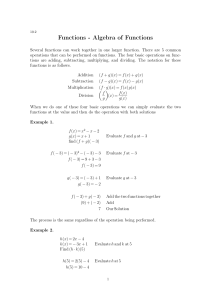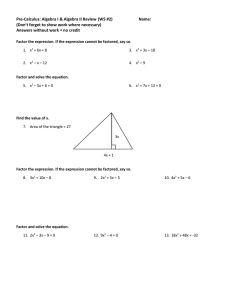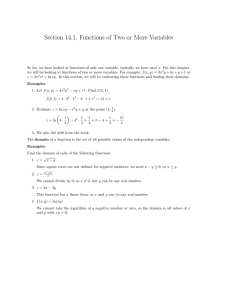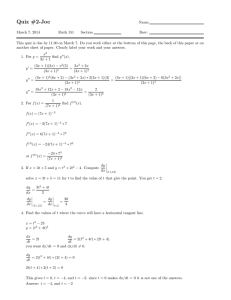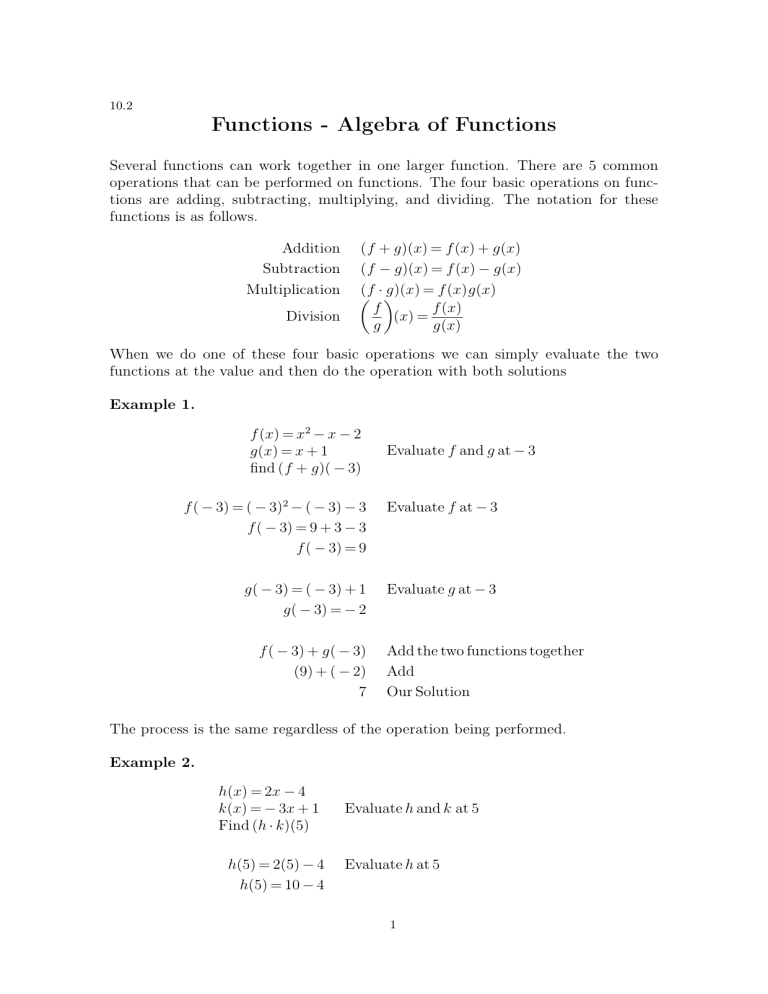
10.2 Functions - Algebra of Functions Several functions can work together in one larger function. There are 5 common operations that can be performed on functions. The four basic operations on functions are adding, subtracting, multiplying, and dividing. The notation for these functions is as follows. Addition Subtraction Multiplication Division (f + g)(x) = f (x) + g(x) (f − g)(x) = f (x) − g(x) (f · g)(x) = f (x)g(x) f (x) f (x) = g(x) g When we do one of these four basic operations we can simply evaluate the two functions at the value and then do the operation with both solutions Example 1. f (x) = x2 − x − 2 g(x) = x + 1 find (f + g)( − 3) Evaluate f and g at − 3 f ( − 3) = ( − 3)2 − ( − 3) − 3 f ( − 3) = 9 + 3 − 3 f ( − 3) = 9 Evaluate f at − 3 g( − 3) = ( − 3) + 1 g( − 3) = − 2 Evaluate g at − 3 f ( − 3) + g( − 3) (9) + ( − 2) 7 Add the two functions together Add Our Solution The process is the same regardless of the operation being performed. Example 2. h(x) = 2x − 4 k(x) = − 3x + 1 Find (h · k)(5) h(5) = 2(5) − 4 h(5) = 10 − 4 Evaluate h and k at 5 Evaluate h at 5 1 h(5) = 6 k(5) = − 3(5) + 1 k(5) = − 15 + 1 k(5) = − 14 h(5)k(5) (6)( − 14) − 84 Evaluate k at 5 Multiply the two results together Multiply Our Solution Often as we add, subtract, multiply, or divide functions, we do so in a way that keeps the variable. If there is no number to plug into the equations we will simply use each equation, in parenthesis, and simplify the expression. Example 3. f (x) = 2x − 4 g(x) = x2 − x + 5 Find (f − g)(x) f (x) − g(x) (2x − 3) − (x2 − x + 5) 2x − 3 − x2 + x − 5 − x2 + 3x − 8 Write subtraction problem of functions Replace f (x) with (2x − 3) and g(x) with (x2 − x + 5) Distribute the negative Combine like terms Our Solution The parenthesis aer very important when we are replacing f (x) and g(x) with a variable. In the previous example we needed the parenthesis to know to distribute the negative. Example 4. f (x) = x2 − 4x − 5 g(x) = x − 5 f Find (x) g f (x) g(x) (x2 − 4x − 5) (x − 5) (x − 5)(x + 1) (x − 5) Write division problem of functions Replace f (x) with (x2 − 4x − 5) and g(x) with (x − 5) To simplify the fraction we must first factor Divide out common factor of x − 5 2 x+1 Our Solution Just as we could substitute an expression into evaluating functions, we can substitute an expression into the operations on functions. Example 5. f (x) = 2x − 1 g(x) = x + 4 Find (f + g)(x2) f (x2) + g(x2) [2(x2) − 1] + [(x2) + 4] 2x2 − 1 + x2 + 4 3x2 + 3 Write as a sum of functions Replace x in f (x) and g(x) with x2 Distribute the + does not change the problem Combine like terms Our Solution Example 6. f (x) = 2x − 1 g(x) = x + 4 Find (f · g)(3x) f (3x)g(3x) [2(3x) − 1][(3x) + 4] (6x − 1)(3x + 4) 18x2 + 24x − 3x − 4 18x2 + 21x − 4 Write as a product of functions Replace x in f (x) and g(x) with 3x Multiply our 2(3x) FOIL Combine like terms Our Solution The fifth operation of functions is called composition of functions. A composition of functions is a function inside of a function. The notation used for composition of functions is: (f ◦ g)(x) = f (g(x)) To calculate a composition of function we will evaluate the inner function and substitute the answer into the outer function. This is shown in the following example. Example 7. a(x) = x2 − 2x + 1 b(x) = x − 5 Find (a ◦ b)(3) Rewrite as a function in function 3 a(b(3)) b(3) = (3) − 5 = − 2 a( − 2) = ( − 2)2 − 2( − 2) + 1 a( − 2) = 4 + 4 + 1 a( − 2) = 9 Evaluate the inner function first, b(3) This solution is put into a, a( − 2) Evaluate Add Our Solution We can also evaluate a composition of functions at a variable. In these problems we will take the inside function and substitute into the outside function. Example 8. f (x) = x2 − x g(x) = x + 3 Find (f ◦ g)(x) f (g(x)) f (x + 3) 2 (x + 3) − (x + 3) 2 (x + 6x + 9) − (x + 3) x2 + 6x + 9 − x − 3 x2 + 5x + 6 Rewrite as a function in function Replace g(x) with x + 3 Replace the variables in f with (x + 3) Evaluate exponent Distirbute negative Combine like terms Our Solution It is important to note that very rarely is (f ◦ g)(x) the same as (g ◦ f )(x) as the following example will show, using the same equations, but compositing them in the opposite direction. Example 9. f (x) = x2 − x g(x) = x + 3 Find (g ◦ f )(x) g(f (x)) g(x2 − x) (x2 − x) + 3 x2 − x + 3 Rewrite as a function in function Replace f (x) with x2 − x Replace the variable in g with (x2 − x) Here the parenthesis don ′t change the expression Our Solution Beginning and Intermediate Algebra by Tyler Wallace is licensed under a Creative Commons Attribution 3.0 Unported License. (http://creativecommons.org/licenses/by/3.0/) 4 10.2 Practice - Algebra of Functions Perform the indicated operations. 1) g(a) = a3 + 5a2 f(a) = 2a + 4 Find g(3) + f (3) 21) g(x) = 4x + 5 h(x) = x2 + 5x Find g(x) · h(x) 3) g(a) = 3a + 3 f (a) = 2a − 2 Find (g + f )(9) 23) f (x) = x2 − 5x g(x) = x + 5 Find (f + g)(x) 5) g(x) = x + 3 f(x) = − x + 4 Find (g − f )(3) 25) g(n) = n2 + 5 f (n) = 3n + 5 Find g(n) ÷ f (n) 7) g(x) = x2 + 2 f (x) = 2x + 5 Find (g − f )(0) 27) g(a) = − 2a + 5 f (a) = 3a + 5 g Find ( f )(a) 9) g(t) = t − 3 h(t) = − 3t3 + 6t Find g(1) + h(1) 29) h(n) = n3 + 4n g(n) = 4n + 5 Find h(n) + g(n) 11) h(t) = t + 5 g(t) = 3t − 5 Find (h · g)(5) 31) g(n) = n2 − 4n h(n) = n − 5 Find g(n2) · h(n2) 13) h(n) = 2n − 1 g(n) = 3n − 5 Find h(0) ÷ g(0) 33) f (x) = 2x g(x) = − 3x − 1 Find (f + g)( − 4 − x) 15) f (a) = − 2a − 4 g(a) = a2 + 3 f Find ( g )(7) 35) f (t) = t2 + 4t g(t) = 4t + 2 Find f (t2) + g(t2) 17) g(x) = − x3 − 2 h(x) = 4x Find (g − h)(x) 37) g(a) = a3 + 2a h(a) = 3a + 4 g Find ( h )( − x) 19) f (x) = − 3x + 2 g(x) = x2 + 5x Find (f − g)(x) 39) f (n) = − 3n2 + 1 g(n) = 2n + 1 5 n 6) g(x) = − 4x + 1 h(x) = − 2x − 1 Find g(5) + h(5) Find (f − g)( 3 ) 41) f (x) = − 4x + 1 g(x) = 4x + 3 Find (f ◦ g)(9) 8) g(x) = 3x + 1 f (x) = x3 + 3x2 Find g(2) · f (2) 43) h(a) = 3a + 3 g(a) = a + 1 Find (h ◦ g)(5) 10) f (n) = n − 5 g(n) = 4n + 2 Find (f + g)( − 8) 45) g(x) = x + 4 h(x) = x2 − 1 Find (g ◦ h)(10) 12) g(a) = 3a − 2 h(a) = 4a − 2 Find (g + h) ( − 10) 47) f (n) = − 4n + 2 g(n) = n + 4 Find (f ◦ g)(9) 14) g(x) = x2 − 2 h(x) = 2x + 5 Find g( − 6) + h( − 6) 49) g(x) = 2x − 4 h(x) = 2x3 + 4x2 Find (g ◦ h)(3) 16) g(n) = n2 − 3 h(n) = 2n − 3 Find (g − h)(n) 51) g(x) = x2 − 5x h(x) = 4x + 4 Find (g ◦ h)(x) 18) g(x) = 2x − 3 h(x) = x3 − 2x2 + 2x Find (g − h)(x) 53) f (a) = − 2a + 2 g(a) = 4a Find (f ◦ g)(a) 20) g(t) = t − 4 h(t) = 2t Find (g · h)(t) 55) g(x) = 4x + 4 f (x) = x3 − 1 Find (g ◦ f )(x) 22) g(t) = − 2t2 − 5t h(t) = t + 5 Find g(t) · h(t) 57) g(x) = − x + 5 f (x) = 2x − 3 Find (g ◦ f )(x) 24) f (x) = 4x − 4 g(x) = 3x2 − 5 Find (f + g)(x) 59) f (t) = 4t + 3 g(t) = − 4t − 2 Find (f ◦ g)(t) 26) f (x) = 2x + 4 g(x) = 4x − 5 Find f (x) − g(x) 2) f (x) = − 3x2 + 3x g(x) = 2x + 5 Find f ( − 4) ÷ g( − 4) 28) g(t) = t3 + 3t2 h(t) = 3t − 5 Find g(t) − h(t) 4) g(x) = 4x + 3 h(x) = x3 − 2x2 Find (g − h)( − 1) 30) f (x) = 4x + 2 g(x) = x2 + 2x 6 46) f (a) = 2a − 4 g(a) = a2 + 2a Find (f ◦ g)( − 4) Find f (x) ÷ g(x) 32) g(n) = n + 5 h(n) = 2n − 5 Find (g · h)( − 3n) 48) g(x) = 3x + 4 h(x) = x3 + 3x Find (g ◦ h)(3) 34) g(a) = − 2a h(a) = 3a Find g(4n) ÷ h(4n) 50) g(a) = a2 + 3 Find (g ◦ g)( − 3) 36) h(n) = 3n − 2 g(n) = − 3n2 − 4n n n Find h( 3 ) ÷ g( 3 ) 52) g(a) = 2a + 4 h(a) = − 4a + 5 Find (g ◦ h)(a) 38) g(x) = − 4x + 2 h(x) = x2 − 5 Find g(x2) + h(x2) 54) g(t) = − t − 4 Find (g ◦ g)(t) 56) f (n) = − 2n2 − 4n g(n) = n + 2 Find (f ◦ g)(n) 40) f (n) = 3n + 4 g(n) = n3 − 5n n n Find f ( 2 ) − g( 2 ) 42) g(x) = x − 1 Find (g ◦ g)(7) 58) g(t) = t3 − t f (t) = 3t − 4 Find (g ◦ f )(t) 44) g(t) = t + 3 h(t) = 2t − 5 Find (g ◦ h)(3) 60) f (x) = 3x − 4 g(x) = x3 + 2x2 Find (f ◦ g)(x) Beginning and Intermediate Algebra by Tyler Wallace is licensed under a Creative Commons Attribution 3.0 Unported License. (http://creativecommons.org/licenses/by/3.0/) 7 10.2 Answers - Algebra of Functions 1) 82 28) t3 + 3t2 − 3t + 5 2) 20 29) n3 + 8n + 5 3) 46 30) 4) 2 31) n6 − 9n4 + 20n2 5) 5 32) 18n2 − 15n − 25 6) − 30 33) x + 3 7) − 3 34) − 3 8) 140 35) t4 + 8t2 + 2 4x + 2 x2 + 2x 2 2 9) − 3 36) 3n − 6 − n2 − 4n 37) − x3 − 2x − 3x + 4 10) − 43 11) 100 38) x4 − 4x2 − 3 12) − 74 13) 1 5 14) 27 9 39) − n2 − 2n 3 40) 32 + 32n − n3 8 15) − 26 41) − 155 16) n2 − 2n 42) 5 17) − x3 − 4x − 2 43) 21 18) − x3 + 2x2 − 3 44) 4 19) − x2 − 8x + 2 45) 103 20) 2t2 − 8t 46) 12 47) 050 21) 4x3 + 25x2 + 25x 48) 112 22) − 2t3 − 15t2 − 25t 49) 176 23) x2 − 4x + 5 50) 147 24) 3x2 + 4x − 9 25) 51) 16x2 + 12x − 4 n2 + 5 3n + 5 52) − 8a + 14 26) − 2x + 9 27) 53) − 8a + 2 − 2a + 5 3a + 5 54) t 8 55) 4x3 58) 27t3 − 108t2 + 141t − 60 56) − 2n2 − 12n − 16 59) − 16t − 5 57) − 2x + 8 60) 3x3 + 6x2 − 4 Beginning and Intermediate Algebra by Tyler Wallace is licensed under a Creative Commons Attribution 3.0 Unported License. (http://creativecommons.org/licenses/by/3.0/) 9
